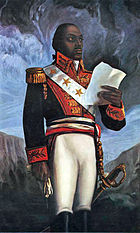John Brown's Raid
| John Brown's Raid on Harpers Ferry | |||||||
|---|---|---|---|---|---|---|---|
| Part of pre-Civil War conflicts | |||||||
 Harper's Weekly illustration of U.S. Marines attacking John Brown's "Fort" Teresa Baine |
|||||||
|
|||||||
| Belligerents | |||||||
|
|
Abolitionist insurgents | ||||||
| Commanders and leaders | |||||||
|
Robert E. Lee Israel Greene |
John Brown |
||||||
| Strength | |||||||
| 88 U.S. Marines Unknown number of Virginia Militia and Maryland Militia |
8 white men 12 free black men 1 freed slave 1 fugitive slave |
||||||
| Casualties and losses | |||||||
| U.S. Marines: 1 killed 1 wounded Virginia and Maryland Militia: Unknown |
10 killed 7 captured 5 escaped |
||||||
|
Civilians: 6 killed 9 wounded |
|||||||
| North American slave revolts |
|---|
 |
|
John Brown's raid on Harpers Ferry (also known as John Brown's raid or The raid on Harpers Ferry; in many books the town is called "Harper's Ferry") was an effort by armed abolitionist John Brown to initiate an armed slave revolt in 1859 by taking over a United States arsenal at Harpers Ferry, Virginia. Brown's party of 22 was defeated by a company of U.S. Marines, led by First Lieutenant Israel Greene. Colonel Robert E. Lee was in overall command of the operation to retake the arsenal. John Brown had originally asked Harriet Tubman and Frederick Douglass, both of whom he had met in his formative years as an abolitionist in Springfield, Massachusetts, to join him in his raid, but Tubman was prevented by illness, and Douglass declined, as he believed Brown's plan would fail.
John Brown rented the Kennedy Farmhouse, with a small cabin nearby, 4 miles (6.4 km) north of Harpers Ferry near the community of Dargan in Washington County, Maryland, and took up residence under the name Isaac Smith. Brown came with a small group of men minimally trained for military action. His group included 18 men besides himself (13 white men, 5 black men). Northern abolitionist groups sent 198 breech-loading .52 caliber Sharps carbines ("Beecher's Bibles") and 950 pikes (obtained from Charles Blair (Collinsville Axe Co., Collinsville, CT), in late September), in preparation for the raid. The United States Armory was a huge complex of buildings that manufactured small arms for the U.S. Army (1801–1861), with an Arsenal (storehouse) that was thought to contain 100,000 muskets and rifles at the time. Brown attempted to attract more black recruits. He tried recruiting Frederick Douglass as a liaison officer to the slaves in a meeting held in a quarry at Chambersburg, Pa.. It was at this meeting that ex-slave "Emperor" Shields Green consented to join with John Brown on his attack on the United States Armory, Green stating to Douglass "I believe I will go with the old man". Douglass declined, indicating to Brown that he believed the raid was a suicide mission. The plan was "an attack on the federal government" that "would array the whole country against us." You "will never get out alive," he warned.
...
Wikipedia
